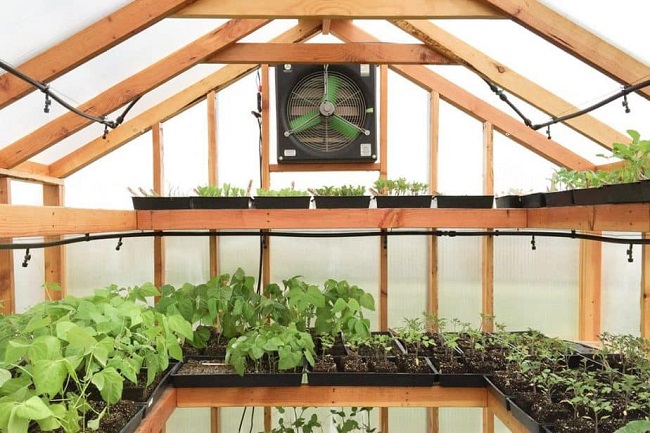
Proper ventilation is easy to neglect when building a greenhouse, but it is crucial to ensuring healthy plants. After all, if your plants do not have fresh air, they are not taking in the carbon dioxide necessary for plant growth. Adequate ventilation also helps to manage temperature and humidity levels, though many modern greenhouses now have separate climate control systems. Ventilation happens in one of two forms: natural (or passive) ventilation and forced (or powered) ventilation.
Natural ventilation relies on hot air naturally rising above colder air. This warm air escapes through exhaust vents at the top of the greenhouse. Meanwhile, intake vents located along the ground bring in cold air, which will gradually warm while inside the greenhouse before eventually exiting through the top vents, completing the cycle. Cold air is drawn into the greenhouse by the vacuum created when the warm air exits. When there are strong winds, this natural process is accelerated. Because of this, intake vents should be built on a windward wall. Vents do require semi-regular maintenance—the passive aspect only applies to the act of ventilation. Thorough cleaning is necessary to prevent debris buildup or pest invasions. If you live in an especially windy area, an automatic wind sensor is recommended, as especially strong winds can damage parts of an exposed vent.
Forced ventilation is typically accomplished using fans. Because you are providing energy, this type of ventilation operates independently of weather conditions. You also receive more control over your greenhouse climate and air circulation when you use forced ventilation. When selecting a fan for a greenhouse in a moderate climate, you ideally want the fan to exchange the air in an 8 ft tall cube within 1 minute. The length and width of the cube are determined by the dimensions of your greenhouse. On average, a greenhouse with a properly fitted fan will be around 10 degrees cooler than a greenhouse using passive ventilation. Of course, additional methods of climate control will further impact this average. When placing fans in your greenhouse, we recommend placing intake fans near the bottom of the greenhouse. Exhaust fans should be placed on the opposite side of the greenhouse at the top of the structure. Even though you are using external energy sources (typically electricity) to move air, you should still let nature do the work when possible. Ground level intake fans will draw in cold air. As this air warms inside the greenhouse, it is naturally drawn towards the outtake fan. Finally, an oscillating or circulating fan can be added alongside a forced ventilation setup to ensure that the air movement and humidity throughout your greenhouse is uniform.
If you’re considering making the jump from a hobby greenhouse (these tend to use natural ventilation) to a large-scale or professional greenhouse, or if you plan to invest in building a custom greenhouse, it’s worth your time to investigate forced ventilation setups. As greenhouses increase in size, the cost of installing vents for natural ventilation increases. In contrast, forced ventilation pricing remains relatively constant. If you’re serious about upgrading your hobby greenhouse, or investing in a new custom greenhouse, we recommend checking out Arcadia Glasshouse at ArcadiaGlassHouse.com. They specialize in both glass and polycarbonate greenhouses that combine simple maintenance with timeless quality, and they will work with you to design and modify the greenhouse of your dreams.
Joshua Nichols is the My Garden & Greenhouse Associate Editor
Related Articles & Free Email Newsletter Sign Up
Creating the Correct Foundation for Your Greenhouse
How to Get Started with Organic Gardening in a Greenhouse
Things to Consider Before Purchasing a Greenhouse




Comment here